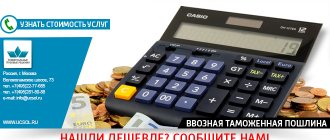Greetings! As soon as a shipment of any product crosses the customs border of a country, its owner must pay a couple of taxes and fees. Moreover, this applies to both import (import of foreign goods into the country) and export (export of “native” goods outside Russia). And the main “extortion” at the border at all times was considered to be customs duties.
And today we will talk about what an ad valorem rate is. And why is it used more often than others when collecting customs duties?
What is ad valorem rate
Customs clearance of imported goods includes payment of customs duties. When crossing the border, each cargo is issued with a declaration with a mandatory indication of the customs value, which is used to calculate the duty.
In general, tax rates combine charges calculated based on the tax base. The ad valorem type, as a type of tax, is also established as a fixed percentage of the value of the object. For imported goods, the ad valorem payment is calculated as a fixed percentage of the customs value.
Import duties for individuals
Individuals have the right to import into Russia, without paying customs duties, goods that fall under the category “for personal use” and are not subject to declaration. The cost of the cargo should not exceed 1,500 € when imported by land or 10,000 € when traveling by air, weight - no more than 50 kg. You are allowed to import 2 blocks of cigarettes, 250 g of tobacco, up to 50 cigars, and up to 3 liters of alcohol duty free.
If any of these standards are exceeded, an individual is obliged to declare the cargo and pay duties on that part of the goods that exceeds the established quotas. An individual can go through customs control through the “red corridor” - for importers of goods that are required to declare and pay duties, or the “green” corridor - for tourists or other persons who do not import cargo for declaration. However, in any case, the customs officer has the right to check the passenger's luggage.
The quantity of goods imported by an individual is also taken into account. If a person is carrying, for example, 30 bottles of the same cologne, a customs officer may force the goods to be declared and duty paid on the basis of suspicion of import for commercial purposes.
Calculation and payment of customs duties
Get a free consultation
Call us or fill out the feedback form and we will contact you as soon as possible.
8 800 700 0952 Feedback
Regulations on rates
All customs regulation on the territory of the Russian Federation is carried out in accordance with the law of November 27, 2010 No. 311-FZ.
The main regulatory document where rates are determined is the federal law “On Customs Tariffs”. The document also defines categories of goods that are not subject to duties or are subject to seasonal duties.
What is import customs duty?
Import customs duty, otherwise known as import duty, is a type of mandatory payment levied by Russian customs authorities when goods are imported into the country. This type of fee is levied all over the world and, despite significant differences in numbers and percentages, there is a general trend that each country follows when forming payments: minimum duties on imports of raw materials for their manufacturers and maximum duties on products that compete with domestic ones. The document regulating the procedure for paying import duties on the territory of the Russian Federation, as well as other countries of the Customs Union (CU), is the Customs Code of the CU.
Import duty is the main type of fee levied on the importer of a product. However, in addition to this, there are so-called indirect import payments, which also need to be made during customs clearance of goods imported into the territory of the countries of the Customs Union. From a legal and economic point of view, all payments can be classified as formed on the basis of the Labor Code - fees and duties, and on the basis of the Tax Code of the Russian Federation - VAT, excise taxes.
- VAT
(value added tax). The payment procedure is regulated by the tax legislation of the Russian Federation and the Labor Code of the Customs Union. - Excise taxes
are regulated by the same documents as VAT. Apply only to the import of excisable goods: tobacco products, alcohol, fuels and lubricants, motor vehicles, etc. A detailed list is in the Tax Code of the Russian Federation. - Customs duties
(payments for customs clearance). These fees are levied by the customs authority for actions to import goods into the country.
Import customs duties are imposed only on products intended for foreign trade. Cargo imported for personal use has quantitative restrictions, but is not subject to these fees (with the exception of cars and some other groups of goods).
Differences from other species
The types of customs duty rates are determined by Art. 71 of the Customs Code of the Russian Federation. In addition to ad valorem, there are:
- Specific – established depending on certain characteristics of goods in kind or physical terms, for example, volume, weight, quantity. An example of a specific rate is the excise tax on diesel fuel, which is set annually. In 2021 it is 8,541 rubles per 1 ton.
- Combined - determined based on a fixed amount and a value calculated as a percentage of the base. An example of combined rates is excise taxes on cigarettes. When calculating in 2019, a fixed value is used for 1 thousand pieces - 1,890 rubles. To this is added 14.5% of the estimated value, determined by the maximum retail sales price. In this case, the minimum retail price used in calculations is 2,568 per 1 thousand pieces.
The main difference between ad valorem rates and other types of rates is the method of its calculation as a percentage of the customs value of the object.
Duties on importing cars into Russia
The amount of customs duty paid for importing a car into the Russian Federation depends on the following indicators:
- status of the importing person (legal or natural);
- purpose of import;
- vehicle cost;
- year of manufacture of the car;
- type of car;
- engine volume and power.
Other important points regarding customs clearance of imported cars that are worth considering:
- customs rates for importing cars do not depend on the country of production, with the exception of Russian ones;
- payments are made in rubles or other currencies;
- You can import no more than 1 car per year for personal use;
- Customs clearance is mandatory for any car, regardless of the method of crossing the border.
When clearing cars through customs, you must pay a fee for customs clearance, customs duties, recycling fees, VAT, and excise taxes. The last two taxes are paid only by legal entities.
The amount of the registration fee depends on the cost of the car and ranges from 500 to 100,000 rubles. The recycling fee is calculated as follows: the base rate is multiplied by a coefficient. The base rate for commercial vehicles is 150,000 rubles. The coefficient depends on the age of the car and engine size: from 1.3 to 9.08 - for cars less than 3 years old, from 6.1 to 35.01 - for cars older than 3 years of production.
The excise tax depends on the engine power of the car: up to 90 hp. – not paid, above – from 45 rubles per 1 hp. (with a power of 91-150 hp) up to 1302 rubles per 1 hp. (with a power of more than 500 hp).
Customs import duties for legal entities are calculated based on the type and engine size and age of the car: 23% - 25% of the cost for cars up to 7 years from the date of manufacture; from 1.4 €/cu.m. cm up to 3.2 €/cu.m. cm – for cars older than 7 years.
VAT – 18% of the sum of the catalog value of the car, customs duties and excise taxes.
Since 2014, the environmental class of an imported car must be at least EURO-5. From the beginning of September 2021, zero duties on the import of electric vehicles have been abolished.
Calculation rules
The currency in which the duty is calculated is important. The calculation of the duty in the national currency of the state where its subsequent payment occurs is legally determined. The use of percentage customs duties is beneficial when importing high-value goods, while for homogeneous goods, for example, building materials, it is more profitable to use fixed or combined ones.
If the imported goods have a cost of 30 thousand rubles and an ad valor rate of 10% is set for it, then for the import of such goods you will need to pay 3 thousand rubles in duty. To obtain the amount of duty for a consignment of goods, you will need to multiply the calculated duty by the number of goods in the consignment.
Benefits, preferences and exemption from customs duties
To calculate customs duties when importing goods into the Russian Federation, various benefits and tariff preferences are applied. Preferences are used to promote the economic development of developing and underdeveloped countries.
Tariff preferences provided for imports into the territory of the Russian Federation are provided for the following groups:
- developing countries - 75% of the base rate of the UCT CU (the list includes 103 countries, including Turkey, Croatia, Malaysia, Chile, etc.);
- less developed - exemption from duties (49 countries, including Ethiopia, Maldives, Guinea, etc.).
Tariff benefits differ from preferences in that they are not individual in nature; when they are provided, it is not the countries of origin that are taken into account, but the purpose of import and the destination of the cargo. For example, the following goods are exempt from customs duties:
- for personal use;
- imported by persons entitled to duty-free import;
- humanitarian aid, cargo to eliminate the consequences of accidents and natural disasters;
- free and charitable assistance;
- all goods imported by individuals (except those prohibited for import and intended for business activities).
Every year, a list of certain types of agricultural goods for import into the Russian Federation is compiled, for which tariff quotas apply. When they are introduced, a duty rate is established on the product, which is lower than the base one.
Please help make this article better. Answer just 3 questions.
Benefits of the bet
The main advantage is the ability to establish a fairer level of tariff protection when applying such rates, which is especially evident during periods of high price fluctuations. Other advantages are:
- The calculation methodology complies with international foreign trade standards
- When calculating, a simple calculation formula is used
- Helps stabilize domestic market prices during periods of foreign market instability
- Reducing the volume of imports of low-quality goods
- In case of non-payment of payment, losses will be minimal
- Used by countries that are members of the WTO
- The methodology for applying ad valorem payments complies with the principles of fair competition
- Can be used for products with different values
Do I need to pay VAT and excise taxes?
In addition to the import duty, participants in foreign economic activity also make other payments - VAT, and, if necessary, excise taxes. The collection of these payments is regulated by the EAEU Labor Code and the Tax Code of the Russian Federation. The basis on which taxes are calculated is the quantity of products and their customs value. As for VAT rates, there are two values - 10% or 20% (from January 1, 2019), which vary depending on the type of imported product. A tax of 20% is applied to most goods, a preferential tax of 10% is applied to some children's goods and types of food. You can find out which goods are subject to VAT in the ETT list by HS code. Certain types of cargo are exempt from VAT:
- medical equipment for diagnostics and treatment, drugs and raw materials for their production;
- humanitarian aid cargo (if they are not subject to excise taxes);
- museum exhibits, objects of national cultural heritage, including domestic;
- literature of all kinds intended for libraries and museums;
- rough diamonds;
- film recordings for educational purposes;
- foreign-made equipment, similar to which is not manufactured in the Russian Federation, and spare parts for it;
- other categories of products specified in Art. 150 Tax Code of Russia.
Excise taxes apply to certain categories of goods that are listed in the Tax Code of the Russian Federation, Article 193, as well as in Letter of the Federal Customs Service of Russia dated December 29, 2017 N 01-11/75571. These are alcohol, tobacco products, transport and other types of goods: when importing products, excise taxes apply on the same products as on the domestic market.
Disadvantages of ad valorem rates
The biggest disadvantage of using interest rates for the state is the possibility of deliberately understating the value of imported goods in declarations.
Then the duty, calculated as a percentage of the cost, will also be significantly reduced. Therefore, when checking declarations, customs officials must compare the established value of the goods with the market average. If the customs tax is several times less than the market value, then the fact of undervaluation is revealed.
In addition, the volatility of the rate is considered a disadvantage. When prices for a specific group of goods fall, it becomes less in demand. After the price level has stabilized, the ad valorem method of calculation is used more actively. Such instability negatively affects the indicator’s ability to protect the national market.
Examples of ad valorem rates
The range of bets is wide. For some groups of goods, minimum rates of 0% apply. The maximum bet is 30%. The maximum rate is applied to natural gas sold. The gas indicator is calculated based on the cost reduced by transportation costs outside the Russian Federation and customs duties.
The mentioned rates do not apply to certain categories of goods, for example, alcoholic beverages, sugar, caviar, buses and cars that have been in operation for more than 5 years. When determining the rates, state policy in the field of state protection of the interests of domestic producers is taken into account.
Terms and procedure for payment of import duties
The procedure for paying import customs duties begins simultaneously with the registration of the customs declaration. At the request of the payer, payment may be made before filing the declaration. From the moment the cargo is presented to the control authority, import duties must be paid within 15 days. Payment is made in euros or national currency. Customs import duty cannot be counted towards the payment of other payments; it is credited to a single account.
In some cases, a deferment or installment plan for the payment of customs duties is allowed; the decision is made by the customs authority within 15 days from the date of filing an application for deferment. In this case, you will have to pay additional interest for the installment/deferment service no later than the last day of termination of obligations to pay the import duty.
What affects the ad valorem tariff
The setting of the tariff is influenced by several factors:
Customs valuation of goods. It is not always objective, which reduces the effectiveness of ad valorem payments.- Political and economic factors.
- The instability of revenues from ad valorem payments reduces the level of protection of the domestic market when a downward trend in prices is identified.
Thus, the level of rates may change up or down as the economic situation in the country changes. A simple calculation method allows you to independently assess the level of duty after determining the customs value of goods.
Top
Write your question in the form below
Who sets these tariffs and rates?
The establishment of ad valorem rates is carried out by the legislator and can fluctuate significantly; they remain unchanged for:
- Alcohol. To sell alcohol in the Russian Federation, you need to pay not only a duty, but also purchase an alcohol license;
- Sahara;
- Caviar;
- Cars with operation over 5 years;
- Furniture with a cost per kg of up to 1.8 euros. You can read how to pay the duty when purchasing furniture from China with delivery here.
Rates can fluctuate both long-term and short-term in order to protect the interests of domestic producers.
Classification of duties according to the method of collection.
Who calculates and collects the duty?
Important: ad valorem duty is collected according to other customs payments by the Federal Customs Service when crossing the border. It is calculated according to the customs declaration for servicing and control of cargo at the border by the same service.
But the customs paperwork is handled by a special department at the enterprise, containing qualified specialists, if the scale of the products imported or exported by it is huge, but if the transportation is not significant, you can turn to the services of logistics companies. Find out how to correctly create a job description for a purchasing and logistics manager in this article.
Objective reasons changing the ad valorem tariff
Its relevance decreases with a decrease in prices and total income of the population. The size of rates may be affected by changes in the economic and political life of the country.
Also, the subjective assessment of goods at customs can have a certain impact on the size of tariffs, which often runs counter to reality.





